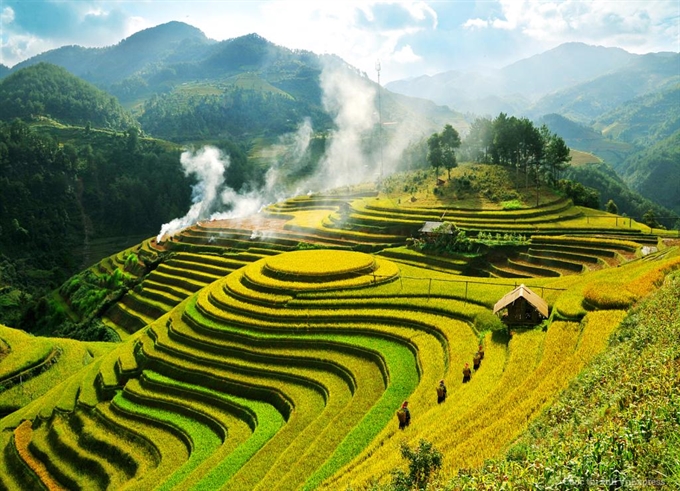 Life & Style
Life & Style

Managers, experts and travel businesses sit together to discuss the plan to develop tourism in northwestern region.
 |
| The Mù Cang Chải terraced paddy field in northern Yên Bái Province. Promoting tourism in the north-western region should not harm the cultural identity of ethnic people and natural resources, factors that make the region attractive to tourists. — Photo vptour.com.vn |
HÀ NỘI – Promoting tourism in the north-western region should not harm the cultural identity of ethnic people and natural resources, factors that make the region attractive to tourists, culture minister has said.
According to Minister of Culture, Sports and Tourism Nguyễn Ngọc Thiện the region has high potential to develop tourism but actually, the work has not been carried out effectively.
A conference was held on Saturday to discuss the tourism potential, obstacles and solutions to develop tourism in eight north-western provinces. It was joined by the Northwest Affairs Steering Committee, local authorities of the north-western provinces and numerous travel companies.
The EU-funded Environmentally and Socially Responsible Tourism Capacity Development Programme (ESRT) also attended the conference as it provided the technical support for the region to promote tourism and organise the National Tourism Year 2017, focussing on the north-western region.
“There are many things to do to promote local tourism, develop the regional economy and improve the people’s living condition,” Thiện said.
“It is necessary to diversify products, improve infrastructure, promote local tourism to the public, call for investments and co-operate with neighbouring provinces.”
The region received 8.9 million tourists in 2015 including 1.6 million foreign tourists, according to Hầu A Lềnh from the Northwest Affairs Steering Committee.
“The tourists focus on several provinces which are easily accessible such as Lào Cai, Lạng Sơn and Phú Thọ,” he said.
“Last year, the number of tourists to Lào Cai increased 42 per cent in comparison with 2014 as Hà Nội – Lào Cai Highway had been opened.”
Tourists often come on the occasion of festivals, not all the year round, for example during the Tam Giác Mạch (Buckwheat) flower festival in Hà Giang, Hoa Ban (Bauhinia Variegata orchid) festival in Điện Biên, Hùng Kings Temple festival in Phú Thọ, and the rice ripening season in Mù Cang Chải, Lềnh said.
“Tourists just come to particular regions and during a specific time, which has not helped in the comprehensive development of tourism in the north-western region,” he said.
The committee considered developing tourism projects among its prioritised tasks with a focus on building exemplary community-based tourist spots and signature projects in each locality.
“Travel agents have a key role in developing regional tourism. They should survey the market, create more projects to meet the demand of tourists,” Lềnh said.
Trần Thế Dũng, vice director of Thế Hệ Trẻ Travel Company in HCM City, said travel agents should join hands with locals to understand the local culture and custom because the identity of ethnic groups in north-western provinces is one among the factors to attract tourists.
“The local workers have created masterpieces such as S-shaped and heart-shaped tea plantations making the green tea fields in Mộc Châu Plateau a charming destination. The travel companies quickly advertise images of these unique tea plantations to lure visitors.”
The head of the International Advisory Group under the EU-ESRT, Mary McKeon, noted that to make the National Tourism Year 2017 successful, Việt Nam needs to give top priority to events throughout the year, connecting related events and organise new events to leave an impression.
She also stressed on the important participation of the business sector, marketing activities and brand identity systems. Besides, to increase the effect of the National Tourism Year, provinces in the region need to focus on three years 2016, 2017 and 2018 to attract the attention of domestic and international visitors and spread the images of the sites.
In 2008, a tourism co-operation pact was signed between extended north-western provinces – Lào Cai, Yên Bái, Phú Thọ, and Hòa Bình, in addition to Sơn La, Điện Biên, Lai Châu and Hà Giang, to tap the local tourism potential and promote tourism growth. Co-operation has covered policy enforcement, tourism product development, human resource training and development, and tourism promotion.
The north-west is defined by ESRT Project as one of the five key areas in need of support for responsible tourism development beside Quảng Ninh, North Central, Central Coast and the Mekong Delta regions.
As scheduled, the 2017 National Tourism Year Northwest – Lào Cai, themed “Colours of the Northwest”, will open in Lào Cai city in February next year. – VNS




